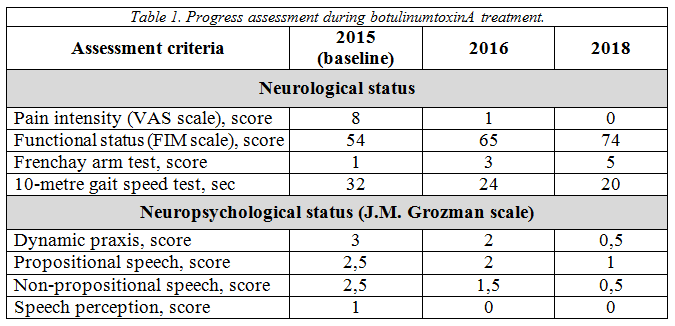Session Information
Date: Tuesday, September 24, 2019
Session Title: Spasticity
Session Time: 1:45pm-3:15pm
Location: Les Muses Terrace, Level 3
Objective: Hemiparesis of various severity is the most common stroke side effect. On average 30-40% of stroke survivors develop post-stroke spasticity. The best neuroplasticity enabling full functional recovery is preserved within 3 months after stroke; afterward rehabilitation is widely considered inefficient. This case study breaks down the stereotypical time frame of efficient rehabilitation and describes high brain neuroplasticity many years after CVA.
Background: In 2002 a 23-year-old patient developed a MCA stroke (caused by primary APS) with severe speech (Broca’s aphasia) and movement (right-sided spastistic hemiparesis) disorders. During the following 13 years the patient has undergone numerous speech and physical therapy courses, however, these only provided short-term relief with no significant neurological improvement. In 2015 the patient was first complexly assessed with the following baseline results: neuropsychological status (J.M. Grozman scale, 0 [best] to 4 [worst]): dynamic praxis – 3, propositional speech – 2,5, non-propositional speech – 2,5, speech perception – 1; Frenchay arm test – 1, pain intensity (VAS scale) – 8, functional status (FIM scale) – 54.
Method: The 3-year treatment course included ultrasound-guided botulinumtoxinA injections into spastic muscles every 4 months combined with daily speech therapy and physical exercises suggested in Guided Self-Rehabilitation concept by J.-M. Gracies.
Results: Follow-up assessment in 2016 revealed substantial progress in neuropsychological status. The patient regained simple-structured language skills. Paralyzed limbs exhibited improved motor function, long-term pain in the paresis shoulder ceased. Due to enhanced movement control the patient was able to go swimming and took prizes in nationwide contests.Second follow-up in 2018 showed even more progress by all scales, with enhanced fine motor skills and phrase speech. The patient was able to read simple words, speech perception impairment reduced. [table1]
Conclusion: Treatment results in this case cannot be attributed to spontaneous recovery. Speech recovery was based on relation between voluntary movement disorder and motor speech disorder caused by Broca’s aphasia. BotulinumtoxinA-treatment contributed to patient’s well-being and pain relief which led to increase in motor function and consequently to speech rehabilitation 16 years after the stroke. This proves long-term brain neuroplasticity enabling late recovery after acute CVA.
To cite this abstract in AMA style:
T. Kuznetsova, A. Svetkina. Successful late rehabilitation based on botulinum therapy [abstract]. Mov Disord. 2019; 34 (suppl 2). https://www.mdsabstracts.org/abstract/successful-late-rehabilitation-based-on-botulinum-therapy/. Accessed April 20, 2025.« Back to 2019 International Congress
MDS Abstracts - https://www.mdsabstracts.org/abstract/successful-late-rehabilitation-based-on-botulinum-therapy/

